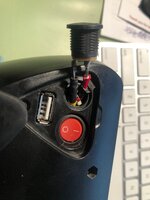creativepart
Active Member
- Region
- USA
I made a bonehead move and shorted the positive pin and the negative spade on the charger input jack on my eBike's battery. If you must know... I was using a multi-meter to test voltage and was too dumb to test it at the main power connections and tested it at the charger input jack. DON'T DO THIS! I was being super cautious to not touch the two multi-meter probes. I was, really. But BANG FLASH!!! I guess I wasn't careful enough. No harm to the battery's operation but the negative spade on the input vaporized a portion of the spade and it was just enough that when you plug in the charger it's difficult to get a good contact. If you hold the charger cable jack just right it will connect but it's tough to hold that long enough to charge the battery.
I found a guy on YouTube that rebuilds batteries for a living and he said this happens a lot because people stick their Key into the battery charge input and BANG FLASH!!! destroy the jack in a similar fashion.
So, following his instructions I opened my battery and sure enough it was super easy to remove the existing jack. I found a 10-pack of replacement 5.5mm x 2.1mm 3 Pin Female DC Power Jacks on Amazon for $6. So, this problem is a solvable problem.
If you... ahem, stick a key in your battery's charger input jack and BANG FLASH!!! there is hope for you yet.

I found a guy on YouTube that rebuilds batteries for a living and he said this happens a lot because people stick their Key into the battery charge input and BANG FLASH!!! destroy the jack in a similar fashion.
So, following his instructions I opened my battery and sure enough it was super easy to remove the existing jack. I found a 10-pack of replacement 5.5mm x 2.1mm 3 Pin Female DC Power Jacks on Amazon for $6. So, this problem is a solvable problem.
If you... ahem, stick a key in your battery's charger input jack and BANG FLASH!!! there is hope for you yet.
